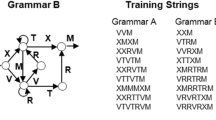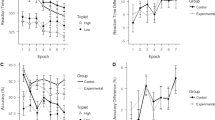Abstract
Three experiments investigated the influence of the response–stimulus interval (RSI) on implicit and explicit learning of stimulus sequences. Participants responded to numerals presented in predetermined positions with alternating long and short RSIs. Half of the participants were instructed explicitly to learn the position sequence. In the transfer phase of Experiments 1 and 2, changing RSI patterns reduced the expression of incidental and intentional learning of position sequence. In Experiment 3 the position sequence was transformed, except that sub-sequences demarcated by long RSIs remained unchanged; this greatly reduced the expression of intentional learning, and slightly reduced that of incidental learning. These results indicate that in implicit learning, stimulus sequences are learned under the constraints of RSIs, whereas in explicit learning, learning independent of RSIs, as well as learning constrained by RSIs, occurs.





Similar content being viewed by others
Notes
In the incidental group, the data of the participants who first performed the test under the original RSI pattern (group a in Fig. 3) might be unreliable, because the differences in RTs between the repeating block (Block 9) and the random block (Block 10) did not differ from the difference between the two repeating blocks (Blocks 5 and 6) in the learning stage. Therefore, the indices were recalculated after excluding the data of group a in the incidental and the intentional groups. The results provided almost same findings as those for the whole group. The index of damage was 63.0 ± 116.9 for the incidental group, and 90.7 ± 102.2 for the intentional group. The indices were 48.5 ± 96.6 ms under the original RSI pattern and 22.8 ± 53.8 ms under the changed RSI pattern for the incidental group, and 232.5 ± 145.5 ms and 87.9 ± 107.2 ms for the intentional group. A 2 × 3 ANOVA with factors of group and index type revealed that the main effects of group and of index type, as well as the interaction, were significant, F(1, 22) = 8.12, MSe = 1, 88, 73.18, p < .01; F(2, 44) = 6.03, MSe = 78, 10.64, p < .01; F(2, 44) = 5.11, MSe = 78, 10.64, p < .05. The results of subsequent tests were the same as those for the whole group, except that the expressed learning for the changed RSI pattern did not differ significantly between the groups.
References
Buchner, A., & Steffens, M. C. (2001). Simultaneous learning of different regularities in sequence learning tasks: Limits and characteristics. Psychological Research, 65, 71–80.
Clegg, B. A., DiGirolamo, G. J., & Keele, S. W. (1998). Sequence learning. Trends in Cognitive Sciences, 2, 275–281.
Destrebecqz, A., & Cleeremans, A. (2001). Can sequence learning be implicit? New evidence with the process dissociation procedure. Psychonomic Bulletin & Review, 8, 343–350.
Destrebecqz, A., & Cleeremans, A. (2003). Temporal effects in sequence learning. In L. Jiménez (Ed.), Attention and implicit learning (pp 181–213). Amsterdam: Benjamins.
Dienes, Z., & Berry, D. C. (1997). Implicit learning: Below the subjective threshold. Psychonomic Bulletin & Review, 4, 3–23.
Dominey, P. F. (1998). Influences of temporal organization on sequence learning and transfer: Comments on Stadler (1995) & Curran & Keele (1993). Journal of Experimental Psychology: Learning, Memory, & Cognition, 24, 234–248.
French, R. M., & Cleeremans, A. (2002). Implicit learning and consciousness: An empirical, philosophical, and computational consensus in the making. Hove: Psychology.
Frensch, P. A., & Miner, C. S. (1994). Effects of presentation rate and individual differences in short-term memory capacity on an indirect measure of serial learning. Memory & Cognition, 22, 95–110.
Frensch, P. A., Buchner, A., & Lin, J. (1994). Implicit learning of unique and ambiguous serial transitions in the presence and absence of distractor task. Journal of Experimental Psychology: Learning, Memory, & Cognition, 20, 567–584.
Goschke, T. (1998). Implicit learning of perceptual and motor sequences. In A. Stadler, & P. A. Frensch (Eds.), Handbook of implicit learning (pp. 401–444). Thousand Oaks: Sage.
Helmuth, L. L., Mayr, U., & Daum, I. (2000). Sequence learning in Parkinson’s disease: A comparison of spatial-attention and number-response sequences. Neuropsychologia, 38, 1443–1451.
Howard, J. H., Mutter, S. A., & Howard, D. V. (1992). Serial pattern learning by event observation. Journal of Experimental Psychology: Learning, Memory, & Cognition, 18, 1029–1039.
Jiménez, L. (2003). Attention and implicit learning. Amsterdam: Benjamins.
Koch, I., & Hoffmann, J. (2000a). The role of stimulus-based and response-based spatial information in sequence learning. Journal of Experimental Psychology: Learning, Memory, & Cognition, 26, 863–882.
Koch, I., & Hoffmann, J. (2000b). Patterns, chunks, and hierarchies in serial reaction-time tasks. Psychological Research, 63, 22–35.
Mayr, U. (1996). Spatial attention and implicit sequence learning: Evidence for independent learning of spatial and nonspatial sequences. Journal of Experimental Psychology: Learning, Memory, & Cognition, 22, 350–364.
McDowall, J., Lustig, A., & Parkin, G. (1995). Indirect learning of event sequences: The effects of divided attention and stimulus continuity. Canadian Journal of Psychology, 49, 415–435.
Nissen, M. J., & Bullmer, P. (1987). Attentional requirements of learning: Evidence from performance measures. Cognitive Psychology, 19, 1–32.
Shin, J. C., & Ivry, R. B. (2002). Concurrent learning of temporal and spatial sequences. Journal of Experimental Psychology: Learning, Memory, & Cognition, 28, 445–457.
Stadler, M. A. (1993). Implicit serial learning: Questions inspired by Hebb (1961). Memory & Cognition, 21, 819–827.
Stadler, M. A. (1995). Role of attention in implicit learning. Journal of Experimental Psychology: Learning, Memory, & Cognition, 21, 674–685.
Willingham, D. B., Greenberg, A. R., & Thomas, R. C. (1997). Response-to-stimulus interval does not affect implicit motor sequence learning, but does affect performance. Memory & Cognition, 25, 534–542.
Ziessler, M. (1998). Response-effect learning as a major component of implicit serial learning. Journal of Experimental Psychology: Learning, Memory, & Cognition, 24, 962–978.
Acknowledgments
I express my appreciation of Takehko Nishimoto, Shizuo Hayashi, Kazuyoshi Fukuzawa, and Masahiko Tomita. I also acknowledge the critiques of the reviewers.
Author information
Authors and Affiliations
Corresponding author
Rights and permissions
About this article
Cite this article
Miyawaki, K. The influence of the response–stimulus interval on implicit and explicit learning of stimulus sequence. Psychological Research 70, 262–272 (2006). https://doi.org/10.1007/s00426-005-0216-y
Received:
Accepted:
Published:
Issue Date:
DOI: https://doi.org/10.1007/s00426-005-0216-y




